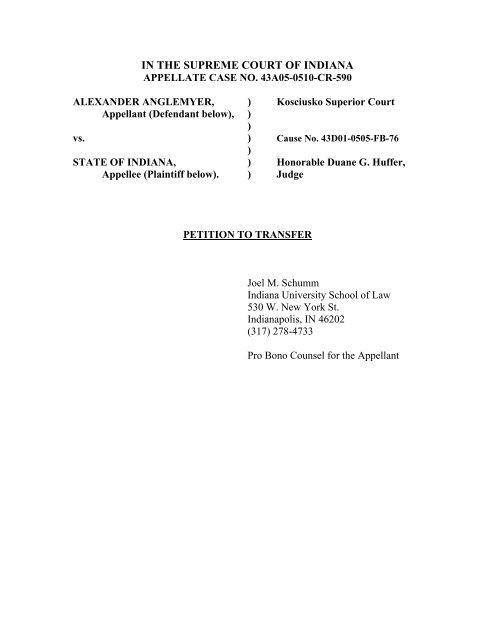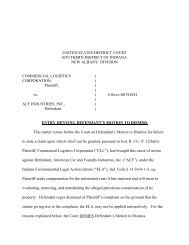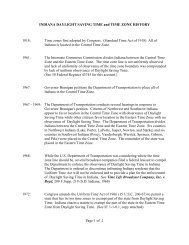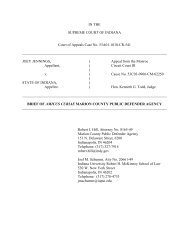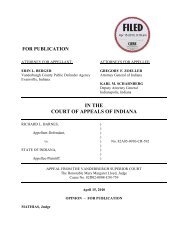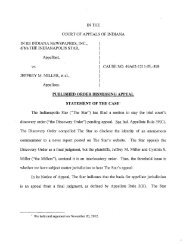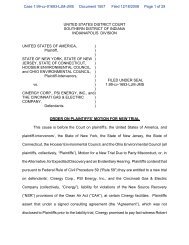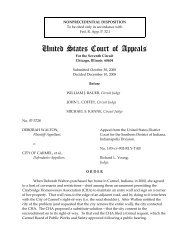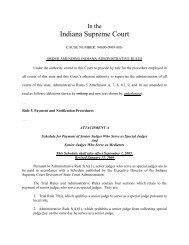transfer petition - The Indiana Law Blog
transfer petition - The Indiana Law Blog
transfer petition - The Indiana Law Blog
Create successful ePaper yourself
Turn your PDF publications into a flip-book with our unique Google optimized e-Paper software.
IN THE SUPREME COURT OF INDIANA<br />
APPELLATE CASE NO. 43A05-0510-CR-590<br />
ALEXANDER ANGLEMYER, ) Kosciusko Superior Court<br />
Appellant (Defendant below), )<br />
)<br />
vs. ) Cause No. 43D01-0505-FB-76<br />
)<br />
STATE OF INDIANA, ) Honorable Duane G. Huffer,<br />
Appellee (Plaintiff below). ) Judge<br />
PETITION TO TRANSFER<br />
Joel M. Schumm<br />
<strong>Indiana</strong> University School of <strong>Law</strong><br />
530 W. New York St.<br />
<strong>Indiana</strong>polis, IN 46202<br />
(317) 278-4733<br />
Pro Bono Counsel for the Appellant
QUESTIONS PRESENTED ON TRANSFER<br />
In the wake of the 2005 amendments to <strong>Indiana</strong>’s sentencing statutes, must trial<br />
courts continue the venerable requirement of a sentencing statement, including the<br />
articulation and weighing of aggravating and mitigating circumstances?<br />
Does a defendant who pleads guilty pursuant to a plea agreement that affords the<br />
trial court considerable sentencing discretion retain the right to challenge the exercise of<br />
that discretion in appealing his sentence?<br />
Is a sixteen-year sentence for B felony robbery and C felony battery procedurally<br />
defective or inappropriate when the trial court fails to find significant mitigating<br />
circumstances clearly supported by the record and aggravates the sentence based on a<br />
criminal history consisting of only two misdemeanors?<br />
1
BACKGROUND AND PRIOR TREATMENT OF ISSUES ON TRANSFER<br />
Nineteen-year-old Alex Anglemyer has not lived an easy life. His father died<br />
when Alex was just five years old. Throughout his childhood Alex was placed on a<br />
variety of different drugs and received inpatient treatment for behavioral disorders,<br />
including Bipolar Mood Disorder and Intermittent Explosive Disorder. App. 15, 17, 70-<br />
72, 82.<br />
By May of 2005, Anglemyer was homeless and jobless when he beat and robbed<br />
a pizza delivery person. Tr. 15; App. 15. He was charged with robbery, a Class B<br />
felony, and battery, a Class C felony. App. 5. Less than three months after his initial<br />
hearing and after just one appearance in court for a pre-trial conference, Anglemyer<br />
entered into a plea agreement to both charges. App. 3-4, 8-10. <strong>The</strong> plea required the<br />
sentences on each count to be served consecutively but capped the executed term at<br />
sixteen years. App. 8.<br />
At sentencing, Anglemyer’s counsel argued that his age and mental illness were<br />
mitigating circumstances. Tr. 14-15. In addition, Anglemyer personally told the court of<br />
his “great remorse” for the offense, personally apologizing to the victim by telling him he<br />
was “very, very sorry” for what he had done. Tr. 16. Anglemyer’s criminal history<br />
consisted only of a misdemeanor conviction for criminal conversion and a misdemeanor<br />
conviction for visiting a common nuisance. App. 14. Nevertheless, the trial court found<br />
as aggravating circumstances “the prior juvenile and criminal history of the Defendant”<br />
and “the seriousness of the offense herein committed,” while finding Anglemyer’s age as<br />
the sole mitigating circumstance. App. 4. It imposed the maximum possible sentence<br />
2
under the plea agreement: sixteen years (ten years for robbery and six for battery)<br />
executed at the Department of Correction. App. 4, Tr. 18.<br />
On appeal, Anglemyer challenged the trial court’s failure to find his significant<br />
mental illness, remorse, and homelessness as mitigating circumstances, the trial court’s<br />
finding of the seriousness of the offense as an aggravating circumstance, and the<br />
appropriateness of the sentence under Appellate Rule 7(B). <strong>The</strong> court of appeals<br />
affirmed in a published decision on April 20, 2006. Pursuant to the 2005 amendments to<br />
<strong>Indiana</strong>’s sentencing statute, the court held that trial courts are “no longer required to<br />
justify any deviation from the presumptive sentence” and any “error in the trial court’s<br />
identification or weighing of [aggravating or mitigating circumstances] is not an issue<br />
that now can be raised on appeal.” Slip op. at 7. Second, it found that Anglemyer had<br />
“waived his appropriateness claim” under Rule 7(B) by agreeing to a sentence “capped”<br />
at sixteen years. Slip op. at 9-10.<br />
ARGUMENT<br />
I. Trial courts must continue the decades-old practice of finding aggravating and<br />
mitigating circumstances and making sentencing statements.<br />
Since the adoption of the modern criminal code in 1977, <strong>Indiana</strong>’s appellate<br />
courts have emphasized the importance of trial courts articulating aggravating and<br />
mitigating circumstances as an integral part of a sentencing hearing. <strong>The</strong> iterations of the<br />
pre-2005 statute have always set a “fixed” or “presumptive” term and required “if the<br />
court finds aggravating circumstances or mitigating circumstances, a statement of the<br />
court’s reasons for selecting the sentence that it imposes,” Ind. Code §§ 35-38-1-3(3)<br />
(2003), and provided that trial courts “may” consider delineated aggravating or mitigating<br />
circumstances, Id. § 35-38-1-7.1(b)&(c).<br />
3
Despite seemingly discretionary language, this Court has long interpreted these<br />
statutes to require “when a judge increases or decreases the basic sentence, suspends the<br />
sentence, or imposes consecutive terms of imprisonment, the record should disclose what<br />
factors were considered by the judge to be mitigating or aggravating circumstances.”<br />
Gardner v. State, 270 Ind. 627, 633, 388 N.E.2d 513, 517 (1979).<br />
More recent cases<br />
focus on three requirements for sentencing statements: “a judge must identify all<br />
significant aggravating and mitigating factors, explain why such factors were found, and<br />
balance the factors in arriving at the sentence.” Bryant v. State, 841 N.E.2d 1154, 1156<br />
(Ind. 2006). <strong>The</strong> important purpose behind these requirements “is to guard ‘against<br />
arbitrary sentences and provide an adequate basis for appellate review.’” Id. (quoting<br />
Morgan v. State, 675 N.E.2d 1067, 1074 (Ind. 1996)).<br />
Hundreds of challenges have been grounded on sentencing errors over the years,<br />
and many have proved successful. On the mitigating side, for example, this Court has<br />
explained that “a defendant who pleads guilty deserves to have mitigating weight<br />
extended to the guilty plea in return.” Francis v. State, 817 N.E.2d 235, 238 (Ind. 2004)<br />
(revising fifty-year sentence for child molesting to thirty years). A lack of criminal<br />
history or longstanding mental illness—when ignored or not credited by trial courts—<br />
have similarly led to appellate reversals. See, e.g., Dowdell v. State, 720 N.E.2d 1146,<br />
1154 (Ind. 1999) (lack of criminal history); Archer v. State, 689 N.E.2d 678, 685 (Ind.<br />
1997) (mental illness). As to aggravators, this Court has explained that the “presumptive<br />
sentence already assumes the underlying elements and that it is therefore improper to<br />
enhance a sentence based on an act for which the defendant is already presumed to be<br />
punished.” West v. State, 755 N.E.2d 173, 186 (Ind. 2001). Other examples of improper<br />
4
aggravating circumstances include a defendant’s criminal history if comprised of only<br />
unrelated misdemeanor convictions, Wooley v. State, 716 N.E.2d 919, 929 (Ind. 1999),<br />
and victim impact unless it is of such a destructive nature not normally associated with<br />
the offense, Bacher v. State, 686 N.E.2d 791, 801 (Ind. 1997).<br />
<strong>The</strong> court of appeals’ sweeping interpretation of the 2005 amendments—<br />
eliminating any need for sentencing statements or the articulation of aggravating and<br />
mitigating circumstances—would seemingly overrule all of these cases and principles.<br />
This interpretation cannot be squared with principles of statutory interpretation when<br />
reading the statute as a whole, Sections 4 and 6 of Article VII of the <strong>Indiana</strong> Constitution,<br />
or this Court’s supervisory power over sentencing procedures in trial courts.<br />
A. Statutory Construction<br />
<strong>The</strong> court of appeals’ view that the 2005 amendments eliminated the requirement<br />
of sentencing statements and explicit findings of aggravating or mitigating circumstances<br />
is inconsistent with the language of those amendments. Statutes pertaining to the same<br />
subject should be harmonized to produce a logical result. Santignon v. State, 749 N.E.2d<br />
1134, 1137 (Ind. 2001). Similarly, “[t]he legislature is presumed to have intended the<br />
language used in the statute to be applied logically and not to bring about an unjust or<br />
absurd result.” Sales v. State, 723 N.E.2d 416, 420 (Ind. 2000). Finally, if there is any<br />
ambiguity in a penal statute, the amendments must be construed strictly against the State.<br />
State v. Downey, 770 N.E.2d 794, 797 (Ind. 2002).<br />
<strong>The</strong> court of appeals noted an apparent conflict between two statutory provisions,<br />
but it made no attempt to harmonize those provisions. Instead, the court of appeals<br />
grounded its decision largely in the amended language that permits trial courts to impose<br />
5
any sentence that is statutorily and constitutionally permissible “regardless of the<br />
presence or absence of aggravating circumstances or mitigating circumstances.” Slip op.<br />
at 6 (quoting Ind. Code § 35-38-1-7.1(d)). It noted a “conflict” between this provision<br />
and the long-standing provision that trial courts must include “a statement of the court’s<br />
reasons for selecting the sentence that is imposes” if it finds aggravating or mitigating<br />
circumstances. Slip op. at 6 (quoting Ind. Code § 35-38-1-3(3)). Nevertheless, the court<br />
concluded that the amended statute renders “any error in such a sentencing statement<br />
moot.” Slip op. at 6.<br />
<strong>The</strong>se statutes can be harmonized, however, by requiring a sentencing statement<br />
under section 1-3(3), which does not conflict with section 7.1(d) because that provision<br />
specifically requires the sentence to be permissible under statutory and constitutional law.<br />
Section 1-3(3) requires a sentencing statement, as does Article VII of the <strong>Indiana</strong><br />
Constitution, as explained in Part B below. It would be illogical, if not absurd, for the<br />
legislature to have retained a lengthy list of aggravating and mitigating circumstances<br />
within the statute if it did not intend for trial courts to rely on them in fashioning a<br />
sentence. Finally, if there is any doubt about the proper interpretation of these penal<br />
amendments, they must be resolved in favor of the Defendant—and defendants benefit<br />
considerably from the requirement of a sentencing statement and articulation of<br />
aggravating and mitigating circumstances.<br />
This view of the statutory language is further bolstered by the “main objective” in<br />
construing a statute: “to determine, give effect to, and implement the intent of the<br />
legislature.” In re K.G., 808 N.E.2d 631, 637 (Ind. 2004). <strong>The</strong>re is little doubt that these<br />
amendments were intended to do nothing more than eliminate the requirement of jury<br />
6
trials for aggravating circumstances in the wake of Blakely v. Washington, 542 U.S. 296<br />
(2004) and Smylie v. State, 823 N.E.2d 679 (Ind. 2005). Slip op. at 4-6; see also Michael<br />
Limrick, Senate Bill 96: How General Assembly Returned Problem of Uniform<br />
Sentencing to <strong>Indiana</strong>’s Appellate Courts, Res Gestae, Jan./Feb. 2006 at 18. As the<br />
amendment’s chief sponsor, Senator Long explained, “<strong>Indiana</strong> sentencing procedures<br />
[could] be changed to avoid the need for any Blakely juries without also working major<br />
changes in the substantive pre-Blakely sentencing law.” Limrick, supra, at 22. Senator<br />
Long, and presumably the scores of other legislators who quickly and unanimously<br />
passed the legislation, realized that this Court was “committed to uniform sentencing”<br />
and they could be “confident that, under the amendment [Long] proposed, appellate<br />
review would continue to prevent wide discrepancies in sentences from one court to<br />
another.” Id. at 23. <strong>The</strong> 2005 amendments rectified the Blakely concerns, but there is no<br />
suggestion that they were intended to do anything more, much less any evidence of intent<br />
to fundamentally alter the time-tested statutes and procedures as the court of appeals held<br />
in this case.<br />
B. <strong>Indiana</strong> Constitution<br />
<strong>The</strong> 2005 amendments also included the requirement that sentences must be<br />
“permissible under the Constitution of the State of <strong>Indiana</strong>; regardless of the presence or<br />
absence of aggravating circumstances or mitigating circumstances.” Ind. Code § 35-37-<br />
1-7.1(d)(2) (emphasis added). <strong>The</strong> court of appeals’ opinion barely mentions this<br />
language and does not attempt to square its holding with the decades of precedent<br />
interpreting the <strong>Indiana</strong> Constitution.<br />
7
Article VII, Sections 4 and 6 of the <strong>Indiana</strong> Constitution were proposed in the<br />
1960s and took effect as constitutional amendments approved by the voters in 1970. See<br />
Walker v. State, 747 N.E.2d 536, 537 (Ind. 2001). Specific language was added to<br />
provide the power to review and revise sentences—a power that was previously not<br />
included. “<strong>The</strong> Commission’s comments demonstrate that the intent of the Amendment<br />
was to expand the role of appellate sentence review, not restrict it.” King v. State, 769<br />
N.E.2d 239, 241 (Ind. Ct. App. 2002) (Najam, J., concurring). <strong>The</strong> purpose was not only<br />
to provide for sentence review but for that review to mimic the substantive, nearly de<br />
novo review that was occurring in England. See, e.g., Walker, 747 N.E.2d at 537-38.<br />
<strong>The</strong> laudable goal of the power to review and revise sentences was well stated in<br />
Serino v. State, 798 N.E.2d 852, 854 (Ind. 2003): “[A] respectable legal system attempts<br />
to impose similar sentences on perpetrators committing the same acts who have the same<br />
backgrounds.” Sentencing principles have been developed and applied over the years to<br />
address disparities. 1<br />
For example, defendants who plead guilty in England may not only<br />
challenge their sentence on appeal, “the Court of Appeal has formulated the principle that<br />
. . . an offender’s remorse, expressed in his plea of guilty, may properly be recognized as<br />
a mitigating factor.” Thomas, supra, at 201. This Court has appropriately taken a similar<br />
view, recognizing that an early guilty plea saves the victims from going through a fullblown<br />
trial and conserves limited prosecutorial and judicial resources; therefore, it is a<br />
mitigating circumstance entitled to significant weight. Francis, 817 N.E.2d at 238. Other<br />
principles have become ingrained in appellate review, such as maximum sentences<br />
1<br />
At the time of the 1970 Amendment, the English system included “a complex and<br />
coherent body of sentencing principles and policy,” which had been developed to realize<br />
the goal of eradicating disparities in the sentences imposed by trial courts. D.A. Thomas,<br />
8
should generally be reserved for the worst offenses and worst offenders, see, e.g.,<br />
Buchanan v. State, 699 N.E.2d 655, 657 (Ind. 1998). <strong>The</strong> goal of consistency in<br />
sentencing and the application of these principles will be difficult, if not impossible,<br />
without a sentencing statement from trial courts.<br />
This Court has sometimes addressed separately the appropriateness of a sentence<br />
under Rule 7(B) from a claim that the trial court’s sentencing order failed to include<br />
significant mitigating circumstances or included improper aggravating ones. See, e.g.,<br />
Noojin v. State, 730 N.E.2d 672, 678-79 (Ind. 2000) (applying predecessor rule).<br />
Nevertheless, the appellate review and revise power is intimately tied to what occurs in<br />
the trial court <strong>The</strong> constitutional power places the “central focus on the role of the trial<br />
judge, while reserving for the appellate court the chance to review the matter in a climate<br />
more distant from local clamor.” Serino, 798 N.E.2d at 856-57. 2<br />
Put another way,<br />
appellate sentence review requires a re-examination of all valid aggravating and<br />
mitigating circumstances in light of the nature of the offense and character of the<br />
offender. See Carter v. State, 711 N.E.2d 835, 841 (Ind. 1999) (applying predecessor<br />
rule).<br />
In sum, the constitutional review and revise power can only be exercised when<br />
trial courts make reasoned sentencing statements that articulate aggravating and<br />
mitigating circumstances. In the absence of such statements, no deference may be<br />
afforded to trial courts, and it will be exceedingly difficult, if not impossible, for<br />
Appellate Review of Sentences and the Development of Sentencing Policy: <strong>The</strong> English<br />
Experience, 20 Ala. L. Rev. 193, 194, 197 (1968).<br />
2<br />
As this Court has observed in another context, the lack of findings by the trial court puts<br />
“the appellate court in the precarious position of evaluating the abuse of discretion when<br />
discretion was perhaps never exercised.” Brown v. State, 703 N.E.2d 1010, 1020 (Ind.<br />
1998).<br />
9
appellate advocates to craft sentencing arguments and for this Court and the court of<br />
appeals to engage in meaningful appellate sentence review.<br />
C. Supervisory Power<br />
In addition to the statutory construction and constitutional arguments discussed<br />
above, continuing to require trial courts to articulate and weigh aggravating and<br />
mitigating circumstances as part of a well-reasoned sentencing statement would be a<br />
prudent use of this Court’s supervisory power over trial courts. Article VII, Section 4<br />
grants this Court “supervision of the exercise of jurisdiction by the other courts of the<br />
State,” which has been applied in a variety of contexts in recent years. See, e.g.,<br />
Williams v. State, 690 N.E.2d 162, 169-70 (Ind. 1997) (courtroom security procedures);<br />
Winegeart v. State, 665 N.E.2d 893, 902 (Ind. 1996) (reasonable doubt instruction).<br />
Here, the court of appeals urged trial courts to continue making sentencing<br />
statements for the laudable reason that “a detailed sentencing statement provides us with<br />
a great deal of insight regarding the nature of the offense and the character of the offense<br />
from the trial court who crafted a particular sentence.” Slip op. at 8. This should not<br />
merely be a suggestion. If sentencing statements are optional, some trial judges will<br />
make them and others will not; disparity in sentences will result. Such disparity in trial<br />
courts will make appellate review “difficult to say the least.” Slip op. at 8 (quoting<br />
Limrick, supra, at 24).<br />
Moreover, in the absence of this Court’s intervention, further havoc might be<br />
wreaked upon long-standing sentencing procedures in <strong>Indiana</strong>’s trial courts. A short step<br />
from the court of appeals’ holding that trial courts need not find aggravating or mitigating<br />
circumstances at sentencing is the abolition of any requirement of an opportunity for<br />
10
defendants (or the State) to submit and argue aggravating or mitigating circumstances.<br />
An objection to defendant’s desire to put on evidence of mental illness or to make an<br />
argument about victim impact may well be sustained; the evidence is arguably not<br />
relevant if trial courts may make sentencing decisions without any regard to aggravating<br />
and mitigating circumstances.<br />
Finally, there will surely be many more appeals when defendants are disgruntled<br />
with a cursory sentencing hearing or the imposition of a lengthy prison term with little, or<br />
no, explanation from the trial judge. One objective of appellate sentence review is to<br />
negate the defendant’s perception of the sentencing judge as one who<br />
possesses unbridled power over his future. . . . <strong>The</strong> attitude of the<br />
defendant in this regard is not unimportant as a defendant who has an<br />
opportunity to air his grievances concerning his punishment is more likely<br />
to approach rehabilitation with a positive attitude than one who is<br />
convinced that one person wronged him in passing judgment . . . .<br />
J. Eric Smithburn, Sentencing in <strong>Indiana</strong>: Appellate Court Review of the Trial Court’s<br />
Discretion, 12 Val. U. L. Rev. 221, 223-24 (1978). Hundreds of defendants have<br />
appealed their sentences in recent years even though trial courts generally explain their<br />
reasons in great detail; one can only imagine how many more will appeal their sentences<br />
in the coming years if trial courts say nothing in imposing a maximum or near-maximum<br />
sentence.<br />
Transfer is appropriate to affirm that the 2005 amendments did not alter the<br />
fundamental requirements of sentencing, which are consistent with the statutory scheme<br />
as a whole and vital to effective appellate review and the goal of consistency in<br />
sentencing that has distinguished <strong>Indiana</strong> for decades. Ind. Appellate Rule 57(H)(4)&(6).<br />
Requiring trial courts to continue doing what they have done for the past three decades is<br />
11
the only way—and a very easy way—to guard “against arbitrary sentences and provide<br />
an adequate basis for appellate review.” Morgan, 675 N.E.2d at 1074.<br />
II. A defendant who pleads guilty pursuant to a plea agreement that affords the<br />
trial court sentencing discretion retains the right to challenge the exercise of that<br />
discretion in appealing his sentence.<br />
Relying exclusively on its own precedent, the court of appeals incorrectly held<br />
that Anglemyer had waived his constitutional right to challenge his sentence as<br />
inappropriate under Article VII, Section 6, and Appellate Rule 7(B). Slip op. at 9-10.<br />
This Court heard argument last September and granted <strong>transfer</strong> in two cases that will<br />
resolve the extent to which defendants who plead guilty may challenge their sentences on<br />
appeal. See Childress v. State, 61A01-0409-CR-391; Carroll v. State, 61A04-CR-483.<br />
Anglemyer’s arguments echo those advanced in the Brief of Amicus Curiae Marion<br />
County Public Defender Agency filed in those cases.<br />
This Court has never imposed the types of limitations on sentencing appeals after<br />
a guilty plea embraced by the court of appeals in this and other cases. As Justice Rucker<br />
suggested in his question to counsel for Carroll and Childress early in oral argument,<br />
these cases may be resolved by simply applying this Court’s holding in Tumulty v. State,<br />
666 N.E.2d 394, 396 (Ind. 1996), which permits a sentencing challenge in any case<br />
“where the [trial] court has exercised sentencing discretion.” Here, the plea agreement<br />
required only that the trial court to impose consecutive sentences, which still left<br />
considerable discretion to the trial court, which could have imposed a sentence as short as<br />
eight years (six years for the B felony robbery and two years for the C felony battery)<br />
suspended, or a sentence as long as the sixteen years executed set as a cap in the plea<br />
agreement and imposed by the trial court.<br />
12
<strong>The</strong> combined effect of the court of appeals’ sweeping interpretation of the 2005<br />
amendments and its restrictive view of Appellate Rule 7(B) in guilty plea cases leaves<br />
defendants like Anglemyer with no appellate recourse whatsoever. <strong>The</strong> plethora of<br />
practical concerns raised in the MCPDA brief are even more pronounced, as defendants,<br />
especially those before a judge known to be tough at sentencing, have no incentive to<br />
take a guilty plea that would preclude them from challenging their sentence on any basis<br />
on appeal. If the court of appeals’ decision stands, competent defense counsel would<br />
need to advise clients that the trial court is under no obligation to consider any mitigating<br />
circumstances, even those weighty ones this Court has long recognized, such as entering<br />
a guilty plea, the lack of a criminal history, or a longstanding mental illness. Moreover,<br />
the trial court could impose the maximum possible sentence under the plea agreement<br />
without any mention, let alone a reasoned finding, of aggravating circumstances. Indeed,<br />
a trial court may decide to impose a lengthy sentence based on erroneous information or a<br />
misunderstanding of law, and a defendant would seemingly be powerless to do anything<br />
to challenge this on appeal.<br />
<strong>The</strong> end result would surely be many more—thousands more—trials in those<br />
cases in which defendants have everything to gain (a right to appeal their sentence, not to<br />
mention a chance of acquittal) and nothing to lose by going to trial. <strong>The</strong> better option—<br />
and the one consistent with precedent, policy, practical concerns, and the purpose of the<br />
<strong>Indiana</strong> Constitution—is to continue to allow defendants who plead guilty pursuant to a<br />
plea agreement that affords any sentencing discretion to the trial court the right to<br />
challenge the exercise of that discretion on appeal.<br />
13
III. <strong>The</strong> sixteen-year sentence in this case is both procedurally defective and<br />
inappropriate.<br />
<strong>The</strong> numerous problems with the anything-goes-at-sentencing approach of the<br />
court of appeals in this case are highlighted by the particular facts of this case. <strong>The</strong> trial<br />
court failed to find either Anglemyer’s early guilty plea or his long-standing mental<br />
illness as mitigating circumstances. See Francis, 817 N.E.2d at 238; Archer, 689 N.E.2d<br />
at 685; App. 8-10, 17, 70-72, 82. Moreover, it improperly aggravated his sentence based<br />
on nothing more than elements of the offense, which was not of a destructive nature<br />
beyond what is inherent in the offense, Bacher, 686 N.E.2d at 801; App. 84, Tr. 17-18,<br />
and based on a criminal history consisting of just two misdemeanor convictions of a<br />
different nature from these charges, Wooley, 716 N.E.2d at 929; App. 13-14.<br />
In addition to these procedural defects, the sixteen-year sentence is inappropriate<br />
in light of the nature of the offense and Anglemyer’s character. See Ind. Appellate Rule<br />
7(B). Sixteen years is close to the maximum possible sentence, which should be reserved<br />
for worst offenses and worst offenders. Buchanan, 699 N.E.2d at 657. 3<br />
<strong>The</strong> nature of the<br />
offenses is no worse than the typical robbery or battery, which is accounted for in the<br />
sentencing range. More importantly, Anglemyer’s character points to a mitigated<br />
sentence. Anglemyer was nineteen years old and homeless at the time of the offense; he<br />
had long been struggling with mental illness and his criminal history consisted of merely<br />
3<br />
Convictions for both B felony robbery (taking property by force and resulting in bodily<br />
injury) and C felony battery (touching a person in a rude, angry, or insolent manner that<br />
resulted in bodily injury) involving the same victim raise double jeopardy concerns. See<br />
generally Guyton v. State, 771 N.E.2d 1141 (Ind. 2001). This Court has held, however,<br />
that “Defendants who plead guilty to achieve favorable outcomes give up a plethora of<br />
substantive claims and procedural rights, such as challenges to convictions that would<br />
otherwise constitute double jeopardy.” Lee v. State, 816 N.E.2d 35, 40 (Ind. 2004).<br />
Nevertheless, had this case gone to trial, Anglemyer would seemingly have faced a<br />
14
two misdemeanor convictions. App. 14. He demonstrated great remorse for his actions<br />
and entered a guilty plea within three months of his initial hearing. Tr. 16, App. 3-4, 8-<br />
10. An appropriate sentence—below the advisory term to account for the mitigating<br />
circumstances yet above the minimum sentence—is an aggregate term of ten years. Cf.<br />
Biehl v. State, 738 N.E.2d 337 (Ind. Ct. App. 2000), trans. denied (reducing a<br />
presumptive sentence to the minimum sentence in light of defendant’s lack of criminal<br />
history and long-standing mental illness).<br />
CONCLUSION<br />
For the foregoing reasons, Alex Anglemyer respectfully requests this Court grant<br />
<strong>transfer</strong> and reduce his sentence to ten years.<br />
VERIFICATION<br />
I verify that this <strong>petition</strong> for <strong>transfer</strong> contains no more than 4,200 words.<br />
________________________________<br />
Joel M. Schumm<br />
Pro bono Counsel for the Appellant<br />
maximum possible sentence of twenty years—the maximum for a B felony—because<br />
15
CERTIFICATE OF SERVICE<br />
I hereby certify that two copies of the foregoing Petition to Transfer were duly<br />
served by personal delivery upon the Attorney General of <strong>Indiana</strong> and Deputy Attorney<br />
General Justin F. Roebel, 219 Statehouse, <strong>Indiana</strong>polis, <strong>Indiana</strong>, this 16th day of May,<br />
2006.<br />
________________________________<br />
Joel M. Schumm<br />
Joel M. Schumm<br />
<strong>Indiana</strong> University School of <strong>Law</strong><br />
530 W. New York St.<br />
<strong>Indiana</strong>polis, IN 46202<br />
(317) 278-4733<br />
double jeopardy would preclude a conviction for battery on the same facts.<br />
16


